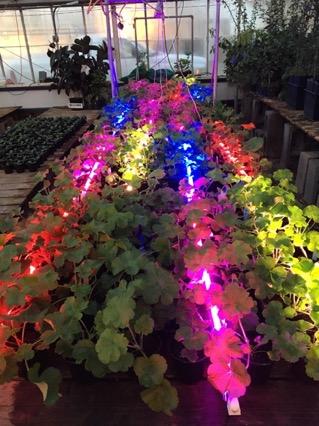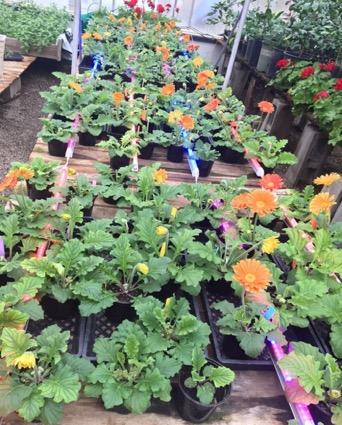LED Technology for Crop Production in Controlled Environments
by Yihe Zou and Heiner Lieth
Light emitting diode (LED) technology has become widespread in all areas where lighting is important as a light source for agricultural crops in controlled environment facilities (greenhouses and indoor production). In horticulture, significant advances have been made in LED lighting over the past 20 years.
LED lamps were first used for plant production lighting as part of a research program on a space shuttle and station. Early on many advancements in LED lighting in the plant sciences were made by scientists in the Netherlands and Japan, with particular focus on seed germination, rooting of cuttings and tissue culture (Nijssen et al. 1990, Miyashita et al. 1995). LED technology has some inherent advantages over traditional forms of horticultural lighting such as incandescent, fluorescent and high-intensity discharge (HID) lamps. In particular, LED lamps tend to have long life, generate less waste heat and provide the potential for creating a perfect spectrum for plant growth. The improved energy use efficiency and reduced heat production make it possible to also position the lamps closer to the plants, offering new opportunities for plant production. These advantages have led to the increasing popularity of LED lamps in plant production, and many growers who are not using LED technology are considering it.
LED or HPS?
Energy costs can be significant in greenhouse production. Thus growers seek to find energy-efficient light sources for greenhouse lighting. Currently, high pressure sodium (HPS) lamps are the most popular lamps in greenhouse production, but various other HID lamp technologies are also being used. Generally HID lamps are marketed by how much wattage they consume because it is assumed that there is a proportional amount of usable light and that this proportion is the same for all lighting technologies. But with the development of LED technology this has changed dramatically. It has become possible to avoid generating any light with wavelengths shorter than 400 nanometers or longer than 700 nanometers, which is the range of wavelengths that is relevant in crop production because plants use only this range of wavelengths for photosynthesis. The light in this range is called photosynthetically active radiation (PAR), but it also happens to be the same range of wavelengths that humans can see (visible wavelengths). So for lamps that are specifically designed to enhance assimilation (photosynthesis) in plants, it is desirable to maximize the amount of energy that ends up as PAR.
Generally the first question growers want to address is the financial side of the picture. So the question arises: “Should growers switch from HID to LED lamps”? A life-cycle cost comparison of LED and HPS lamps by Meng and Runkle (2014) found that the effect on flowering in bedding plants with 150 W HPS lamp and 14 W LEDs is similar, while the cost over the life of the lamps is much lower with LED lamps than with HID lamps. Cost comparisons between LEDs and HPS by Singh et al. (2015) showed significant overall cost savings when using LED lamps for plant production over a 16-year period. Although their analysis showed that LED lamps cost more in the beginning, by the seventh year of use, the HPS lamps cost more than the LED lamps.
Effect of LED Lighting on Plant Growth
Various research projects have been conducted over the past 20 years on the effect of LED lamps for various types of plant growth.
|
Table 1. Effect of LED light on plant growth (Abbreviations: R=Red LEDs, B=Blue LEDs, W=White LEDs, G=Green LEDs, Fr=Far red LEDs) |
|||
|
Category |
Plant |
LED radiation |
Effect on plant growth |
|
Vegetable |
Lettuce |
RBW |
Increased nutritional value and growth (Lin et al. 2013) |
|
Basil
|
B |
Increased amount of essential oil (Amaki et al. 2011) |
|
|
White mustard, Spinach, Green onions |
R + HPS lamps |
Increased vitamin C content (Bliznikas et al. 2012) |
|
|
Sweet pepper |
R +Fr |
Far-red light increased plant height with higher stem biomass (Brown et al. 1995) |
|
|
Flower |
Marigold |
R |
Increased dry weight of marigold seedlings (HEO et al., 2002) |
|
B |
Increased stem length (HEO et al. 2002) |
||
|
Crown of thorns (Euphorbia millii)
|
B; R + Fr; B+ Fr |
Stimulated flowering (Hahn et al. 2006) |
|
|
Petunia, Snapdragon |
R + Fr |
Promoted flowering (Craig and Runkle 2012) |
|
|
Fruit |
Tomato |
B |
Increased fruit yield, improved quality and disease resistance (Xu et al. 2012) |
Table 1 shows some typical results from various LED research projects. Notably some researchers found greater accumulations of biomass through use of particular parts of the light spectrum. For example, adding far-red LED light to red LED light resulted in an increase in plant height and stem biomass of sweet pepper. For flowers, red LED light increased the dry weight of marigold seedlings. For tomato, blue LED light could increase fruit yield, improve quality and disease resistance. There are also examples of research results where the effect was on something other than biomass accumulation. For example, in vegetables such as lettuce, white mustard, spinach and green onions, red LED light increased nutritional value. For basil, blue LED light increased the amount of essential oil. The combination of red and far red LED light was helpful for the flowering of crown of thorns (Euphorbia millii), petunia and snapdragon. As such, the issues related to using LED lighting are more complex than the effect on photosynthesis, and there is much more to learn in this area.
Innovation Using Within-Canopy LEDs
One facet we are exploring at UC Davis is whether we can leverage some of the features of LED lighting technology to provide lighting to plants in ways that were not possible in the past. While traditional overhead lamps are too hot to place close to the foliage, we are investigating whether we can provide supplemental light with LED lamps directly within the canopy of plants, lighting leaves that generally are fully shaded. Our hypothesis is that we can raise the whole-plant photosynthesis by lighting leaves which would otherwise see no direct light. Fully shaded leaves generally provide very little to the plant, perhaps even consuming resources that the plant could use for growth.
Some research using within-canopy supplemental lighting has been done in vegetable crop production. In one example, within-canopy LED light promoted earlier tomato fruit production and allowed for a longer harvest period (Gómez and Mitchell 2013). When compared to traditional overhead light, within-canopy lighting in cucumber increased yield by 11% (Pettersen et al. 2010). Within-canopy lighting in cowpea produced twice as much edible biomass in comparison with an overhead-lighted system (Frantz et al. 2000).
Our current research at UC Davis is examining whether ornamental plant production can be enhanced with within-canopy lighting. We are designing an experiment to be installed in commercial greenhouse flower production facilities to evaluate the effect of lighting the bent canopy of roses and the underside of older leaves in gerbera production. We are also currently using potted gerbera and geraniums as model systems to test this approach on a smaller scale in our research greenhouses at UC Davis (fig. 1).


Fig. 1. Test-model systems of geranium (top) and gerbera (bottom) using LED lighting Photo: Y. Zou.
The LED lamps used in our research have red and blue light or a combination of various spectra consisting of red, blue and white light. Our preliminary results suggest that while the number of flowers produced in lighted geranium and gerbera are not significantly different than the unlighted controls, the stem number of geranium (branching) and the scape length of gerbera are affected, suggesting that it may be possible to manipulate flower quality. This research is still on-going, and we will be repeating the experiment to verify these preliminary results.
Future for LED Lighting
LED lighting technology has already shown many great advantages in controlled environment production. The diversity in spectra, high energy use efficiency, cool operating surface and long life suggest that LED lamps have the potential to become the dominant light source in protected agriculture, particularly in greenhouses or other types of indoor production.
While LED lamps had the reputation in the past of being too expensive, it is relevant to note that economic feasibility is here today for many high-value horticultural crops. The cost of LED lighting has been declining regularly over time and it seems to still be going in that direction. As such, the question is not whether or not LED lighting is economically feasible, but rather for which crops does LED lighting make economic sense and when, ultimately, will it become economically feasible for your plants.
Yihe Zou is a graduate student and Heiner Lieth is Professor Crop Ecologist and UC Cooperative Extension Crop Ecologist, Department of Plant Sciences, UC Davis.
References
Amaki W, Yamazaki N, Ichimura M, Watanabe H. 2011. Effects of light quality on the growth and essential oil content in sweet basil. Acta horticulturae.
Bliznikas Z, Žukauskas A, Samuoliene G, Viršile A, Brazaityte A, Jankauskiene J, Duchovskis P, Novickovas A. 2012. Effect of supplementary pre-harvest LED lighting on the antioxidant and nutritional properties of green vegetables. Acta Hortic 939:85–91.
Brown CS, Schuerger AC, Sager JC. 1995. Growth and photomorphogenesis of pepper plants under red light-emitting diodes with supplemental blue or far-red lighting. Journal of the American Society for Horticultural Science, 120(5):808-813.
Craig DS, Runkle ES. 2012. Using LEDs to quantify the effect of the red to far-red ratio of night-interruption lighting on flowering of photoperiodic crops. In VII International Symposium on Light in Horticultural Systems 956(10):179-186.
Frantz JM, Joly RJ, Mitchell CA. 2000. Intracanopy lighting influences radiation capture, productivity and leaf senescence in cowpea canopies. Journal of the American Society for Horticultural Science 125(6):694-701.
Gómez C, Mitchell CA. 2013. Supplemental lighting for greenhouse-grown tomatoes: Intracanopy LED towers vs. overhead HPS lamps. In International Symposium on New Technologies for Environment Control, Energy-Saving and Crop Production in Greenhouse and Plant 1037 (10): 855-862.
Hahn EJ, Paek KY, Dewir YH, Chakrabarty D. 2006. August. Flowering of Euphorbia millii plantlets in vitro as affected by paclobutrazol, light emitting diodes (LEDs) and sucrose. In XXVII International Horticultural Congress-IHC2006: International Symposium on Plant Biotechnology: From Bench to 764 (pp. 169-174).
Heo J, Lee C, Chakrabarty D, Paek K. 2002. Growth responses of marigold and salvia bedding plants as affected by monochromic or mixture radiation provided by a light-emitting diode (LED). Plant Growth Regulation 38(3):225-230.
Lin KH, Huang MY, Huang WD, Hsu MH, Yang ZW, Yang CM. 2013. The effects of red, blue, and white light-emitting diodes on the growth, development, and edible quality of hydroponically grown lettuce (Lactuca sativa L. var. capitata). Scientia Horticulturae 150: 86-91.
Meng Q, Runkle E. Control flowering with LEDs. 2014. Grower Talks. 79(12). http://www.ballpublishing.com/GrowerTalks/ViewArticle.aspx?articleid=20604.
Miyashita Y, Kitaya Y, Kubota C, Kozai T, Kimura T. 1995. Effects of red and far-red light on the growth and morphology of potato plantlets in-vitro: Using light emitting diodes as a light source for micropropagation. Acta Hort. 393:189–194.
Nijssen CT, Kuhn OA, Verbeek W. 1990. Nijssen Light Division BV Method and Device for Lighting Seeds or Plants. U.S. Patent 4,914,858.
Pettersen RI, Torre S, Gislerød HR, 2010. Effects of intracanopy lighting on photosynthetic characteristics in cucumber. Scientia horticulturae125(2):77-81.
Singh D, Basu C, Meinhardt-Wollweber M, Roth B. 2015. LEDs for energy efficient greenhouse lighting. Renewable and Sustainable Energy Reviews. 49:139-147.
Xu HL, Xu Q, Li F, Feng Y, Qin F, Fang W. 2012. Applications of xerophytophysiology in plant production — LED blue light as a stimulus improved the tomato crop. Scientia Horticulturae 148:190-196.












